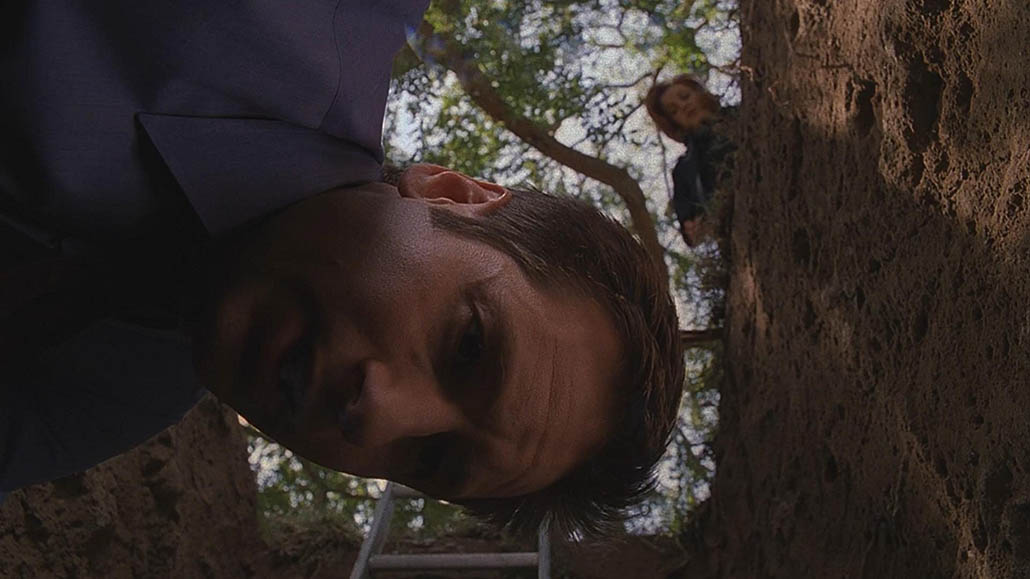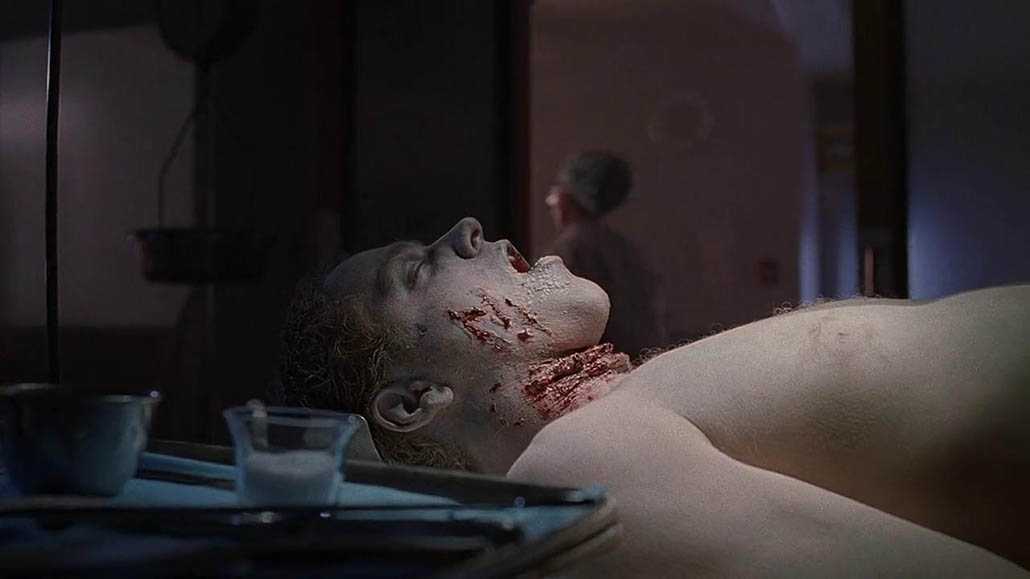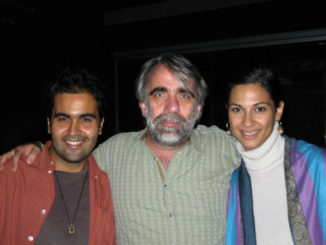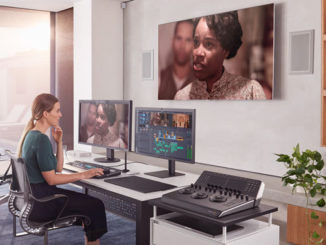
by Linda Dove
The X-Files is a TV phenomenon, with fans across the globe, websites and Internet conventions. Stephen Mark edited the pilot and the series for three seasons before moving on to Millenium. I talked to him just as he was embarking on the X-Files first feature.
Steven Mark:I think of myself as a “film editor” rather than as a “TV editor,” although I’m certainly aware that many people in our industry perceive that there’s some sort of difference between TV, MoW, feature editors, and so on. That perception has probably been an impediment to my working on features since I suspect employers use those distinctions as a way of reducing the number of candidates they need to consider for any given job opening.
But really the basic job of editing is the same in all those formats. There may be subtle differences in the kind of problems that accompany each format-different time constraints, more or less film available for making choices or for solving problems-but all editors are doing the same thing, reacting to the film they receive and deciding how to put the best bits of it into the best order at the best length for telling the story.
I certainly would like to believe that someone looking for a feature editor would consider me as seriously as they would any other experienced editor, and that’s not because I want to abandon television, but rather because major studio features are where the money is in our profession. I have two kids I want to put through college, and I like the way deal making is handled in the feature world much better than in TV.
Any good editor has strong ideas about the best way to play a particular moment in a show and has to be willing to articulate his views to his collaborators.
I can speak with a little experience about this now that I’m working on ‘The X-Files’ movie. It seems that studios negotiate with feature editors based on their personal accomplishments-their track records for doing good (and successful) work, their salary histories, their relationships with the directors and producers who want to hire them. In television -especially series television-the studios view editors as interchangeable.
Editors are a class, not individuals, and there is little meritocracy beyond the fact that you’ve been offered the job at all. The studio sets a rate (usually two to three hundred dollars above scale) for TV editors and leaves little room for negotiation. The quality of work you have done or can do, the degree to which the show you are on is successful, or even how bad the producer wants you on the show, carry very little weight if it means breaking the studio’s precedent about how much it’s decided to pay all its editors.
The Money May Be In Features, But The TV Audience Is Bigger.
Mark: There are some ironies here. For one thing, a TV editor’s work is often seen by more people than a feature editor’s. Even TV flops get bigger audiences than some moderately successful features. A rating point is about 900 to 950 thousand people, so if your ratings are down around 8 or 9, which is not considered wonderful, your show is being seen by 8 million people. If those people paid $7 each to see a film-that’s a $56 million box office.
For another thing, the TV editor may actually have more responsibility for what the audience sees than does a feature editor. We have less time to collaborate with a director than a feature editor does-maybe two or three days as opposed to weeks or months.

The TV editor also spends another three to five days working with the show’s producers, but all in all it’s incumbent upon the TV editor to have his first cut as close to airable as possible. Given the collaborative time available, my philosophy is I don’t want to be revising more than maybe 15% of my cut-especially if I want to be invited back for the next season. I pride myself on the small amount of time directors and producers feel they have to spend with me to get the show right.
The Particular Demands Of Editing For Television
Mark: A series television editor has less film to work with than a feature editor and less time to cut. The smaller amount of film can be an advantage when you’re working fast because obviously you have fewer choices. On the other hand, if something isn’t working, you have fewer ways to solve the problem. Often enormous creativity and resourcefulness are necessary to deal with problems in a TV cutting-room that would never even come up on a feature just because the feature production crew had more time to shoot it right in the first place.
The TV editor also has to deal with the discipline of cutting the show to a time limit. I can only think of a couple of cases where going through this process actually hurt the show aesthetically, and I’m often surprised at how much better a show can get just because we are forced to shorten it. Interestingly, one episode I did that I thought worked better two or three versions earlier than the one we locked was an episode that won both the writer and the guest star, Peter Boyle, Emmy awards last year.
There Are Advantages To Finishing On Tape
Mark: With the speed involved in turning over a TV episode, I view the whole digital revolution as a blessing that has made my job more humane. The fact that we cut in computers and deliver on video instead of film allows for much more flexibility. One of my big “secrets”these days, for adding pace to”an actor’s performance, is to speed up a few frames in between sentences or during a particularly stoic reaction and then returning the shot to normal speed. Sure, you could do it on film, but you wouldn’t know whether it had worked or not without spending money on test opticals-and get the studio to approve that!
I used to tell new assistants that worked for me that I had two rules about being as assistant: the first was don’t leave your coffee on the editing bench and the second was eavesdrop.
I like it that I no longer debate with directors and producers over whether a change note will work or not. I think any good editor has strong ideas about the best way to play a particular moment in a show and has to be willing to articulate his views to his collaborators. But before computers, when working on film, I’d sometimes get change notes that I knew would be long and hard to accomplish yet wouldn’t in my opinion improve the show.
I’d end up in debates with producers or attempts to talk a director out of even trying the change. Now I never argue until I’ve tried the note. It’s no big deal because the original version is saved. We can then look at both versions and discuss which works best. Plus, in going through the process of making the change, I may come up with a third alternative that solves everyone’s problem without hurting the film.
Working Hours And Eavesdropping Assistants
Mark: When I did cut on film, it was not uncommon for me to work until midnight or one in the morning two or three days during the process of getting into a first cut. And I’d still have to send a scene or two out to an editor on the series who had less to do that week or to my assistant. I can recall leaving my cutting room at Universal at 1 am, heading for the parking structure, and literally breaking down in tears because I was so tired, and there was this existential angst about why was I here, this exhausted, over a television show. Now, with this electronic stuff, not only do I tend to work from maybe ten in the morning until maybe six-thirty, I never need somebody to help cut scenes.
That thought leads me to a disturbing aside, however. What does seem to be lost are those situations where I tossed a scene to my assistant because I really needed his help to finish the show. Then he cut it, showed it to me, we worked on revisions, and so on, and it ended up in the cut. The director and producer saw it and, if they liked the scene, I could say, “Well, my assistant did that.” That’s a great way for assistants to get some recognition if they want to move up. Ironically, now an assistant who can find the time to get onto the editing machine can practice cutting absolutely anything he wants. And I suppose if everyone has time, he can show his cuts to the editor and get some feedback. But somehow because the pressure isn’t there-the editor doesn’t need the assistant to do that scene-I don’t see assistants doing much cutting. That chance for recognition is diminished.

There has been a move in television to reduce the number of assistants as a result of electronic editing. The belief is that because the assistants can’t get on the machine when the editor’s on it, they spend a lot of time sitting around, therefore they should be able to assist on more than one show at a time. For the past two seasons at Fox there have been two assistants for three editors. This, to me, is an appalling situation. Maybe the assistants can handle the work in the sense that they do what they’re told, but what they can’t do is go beyond the minimum requirements, much less find time to do some cutting.
When I judge an assistant personally, what I look for is how well does this person do what I want done before it occurs to me to ask him. I used to tell new assistants that worked for me that I had two rules about being as assistant: the first was don’t leave your coffee on the editing bench and the second was eavesdrop. If you’re not in the cutting room eavesdropping, anticipating what needs doing, then you’re waiting for the editor to tell you everything, and I’m not fond of that.
With the system imposed on us at Fox, if I need an assistant, I have to go hunt one up, and if he’s busy with someone else, I’d better write down what I want so I don’t forget it myself and once I do communicate what I need, I can forget about him following up on it unless I remind him. So if I ask three days later, “Whatever happened to that temp sound effect I needed?” The answer is, “Oh, yeah, I called about that and the guy hasn’t gotten back to me.” And what can I say? The poor assistant’s been trying to get someone else’s show ready for online and I took a back seat.
All editors are doing the same thing, reacting to the film they receive and deciding how to put the best bits of it into the best order at the best length for telling the story.
I asked Stephen if he would be trying to maintain the specific style of The X-Files in the feature.
Mark: My style is the result of how my personality, my judgment of performance and photography, and my intuitive sense of rhythm react to the film that I see. It’s not something that I impose consciously- although I do a lot of intellectual analysis when I realize something isn’t working.
Once I focus on where that problem is, I still go back to my gut reaction to find the solution. If the feature is shot differently than the series, I suppose I might react to it differently.
The director of the movie, Rob Bowman, is one of the most stylish of the X-Files series’ directors, so I doubt that the fundamental style will be different. What will be new for me (although I have cut low budget features, so I shouldn’t act as quite such a novice) is that I think cuts look different on a big screen than they do on video.
We’re shooting super 35, which is a new thing to me, and we’re going to telecine with a hard matte-I think it’s a 2.4 to 1 aspect ratio or something odd like that. I want a really big Avid monitor to get the sense of how that’s going to feel. We’ll be conforming the workprint so we can go into a screening room periodically and see the cuts.
We use a lot of intense close-ups in the series, and seeing those ECU’s on a wide screen may sometimes look ridiculous depending on the moment. I may have to learn where to back off on that stuff. Ultimately, of course, this will be the director’s call, but it will be interesting for me to see how it works.





